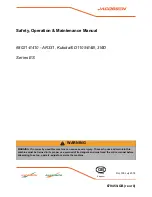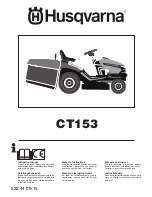
4.
Pump the priming plunger until you feel resis-
tance. Try to start the engine. If the engine does
not start repeat step 3.
Figure 14
1.
Primer plunger
2.
Bleed screw
Figure 15
1.
Injection pump fitting
Note: It may be necessary to bleed the air out of the
fuel line between the fuel filter/water separator and the
injection pump. To do this, loosen the fitting on the
injection pump (Fig. 15) and repeat the bleeding pro-
cedure.
CHECKING THE INTERLOCK
SYSTEM.
The interlock system prevents the engine from crank-
ing or starting unless the traction pedal is in NEU-
TRAL and the cutting unit engagement switch is DIS-
ENGAGED. In addition, the engine will stop when
the cutting unit engagement switch is engaged or the
traction pedal is depressed when the operator is off the
seat.
1.
In a wide open area free of debris and bystanders,
lower the cutting units to the ground. Stop the
engine.
2.
Move the cutting unit engagement switch to DIS-
ENGAGED and remove your foot from the trac-
tion pedal.
3.
Turn the ignition key to START. The engine
should crank. If the engine cranks, go to step 4.
If the engine does not crank, there may be a mal-
function in the interlock system.
4.
Rise off the seat and engage the cutting unit
engagement switch while the engine is running.
The engine should stop within 2 seconds. If the
engine stops, the switch is operating correctly;
thus, go to step 5. If the engine does not stop,
there is a malfunction in the interlock system.
5.
Rise off the seat and depress the traction pedal
while the engine is running and the cutting unit
engagement switch is DISENGAGED. The
engine should stop within 2 seconds. If the
engine stops, the switch is operating correctly;
thus, continue operation. If the engine does not
stop, there is a malfunction in the interlock sys-
tem.
18
Operation
➀
➁
The interlock switches are for the operator’s protec-
tion, so do not disconnect them. Check operation of
the switches daily to assure the interlock system is
operating. If a switch is defective, replace it before
operating. Regardless of whether the switches are
operating correctly or not, replace them every two
years to assure maximum safety. Do not rely entire-
ly on safety switches—use common sense.
CAUTION











































